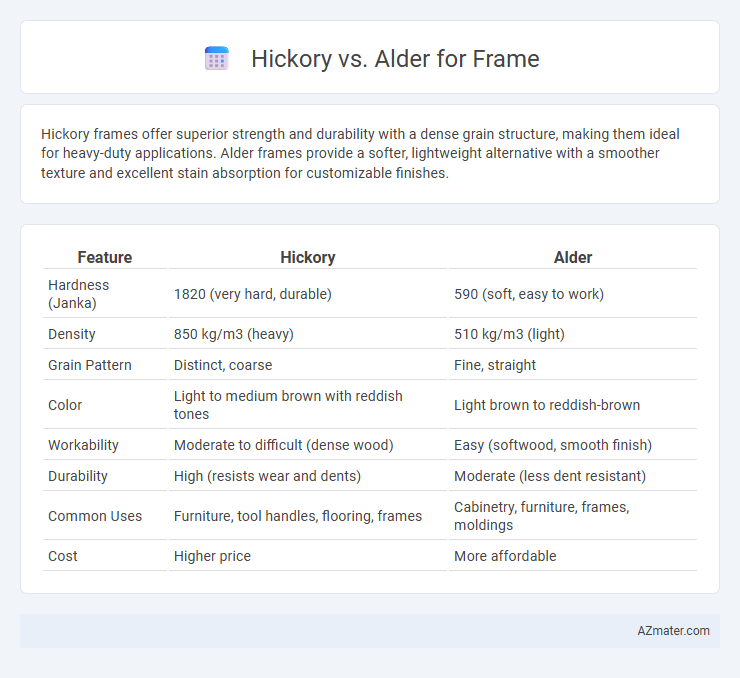Hickory frames offer superior strength and durability with a dense grain structure, making them ideal for heavy-duty applications. Alder frames provide a softer, lightweight alternative with a smoother texture and excellent stain absorption for customizable finishes.
Table of Comparison
| Feature | Hickory | Alder |
|---|---|---|
| Hardness (Janka) | 1820 (very hard, durable) | 590 (soft, easy to work) |
| Density | 850 kg/m3 (heavy) | 510 kg/m3 (light) |
| Grain Pattern | Distinct, coarse | Fine, straight |
| Color | Light to medium brown with reddish tones | Light brown to reddish-brown |
| Workability | Moderate to difficult (dense wood) | Easy (softwood, smooth finish) |
| Durability | High (resists wear and dents) | Moderate (less dent resistant) |
| Common Uses | Furniture, tool handles, flooring, frames | Cabinetry, furniture, frames, moldings |
| Cost | Higher price | More affordable |
Introduction to Hickory and Alder for Frames
Hickory and alder are popular hardwood choices for frames due to their durability and aesthetic appeal. Hickory offers exceptional strength with a distinctive grain pattern that enhances rustic and traditional designs. Alder provides a smoother texture and lighter tone, making it ideal for contemporary frames with a warm, natural finish.
Key Characteristics of Hickory Wood
Hickory wood is renowned for its exceptional hardness and density, making it highly durable and resistant to wear, which is ideal for door frames requiring robust structural support. Its pronounced grain pattern and light to medium brown color with reddish hues offer a distinctive, rustic aesthetic that enhances interior design. Hickory's high shock resistance and strength surpass alder, providing greater longevity and stability in frame applications.
Key Characteristics of Alder Wood
Alder wood is a soft hardwood known for its fine, straight grain and uniform texture, making it ideal for detailed frame work. Its light brown to reddish-brown color offers a warm, consistent appearance that easily accepts stains and finishes, enhancing versatility. Compared to Hickory, Alder provides a smoother surface but is less dense, resulting in lower durability and impact resistance for frames.
Durability Comparison: Hickory vs Alder
Hickory offers superior durability compared to alder due to its higher Janka hardness rating of 1820, making it more resistant to dents, scratches, and daily wear. Alder, with a Janka hardness of 590, is softer and more prone to dings, making it better suited for decorative frames rather than heavy-use applications. The dense grain structure of hickory contributes to its robustness and long-lasting performance, especially in high-traffic or impact-prone environments.
Aesthetic Differences: Grain, Color, and Texture
Hickory frames showcase a bold, distinctive grain pattern characterized by strong contrasts and pronounced knots, offering a rugged and rustic aesthetic with warm, reddish-brown hues that deepen over time. Alder frames feature a smoother, more uniform grain with subtle variations, presenting a softer, more refined look emphasized by light brown to reddish tones that promote a natural, cozy ambiance. The coarse texture of hickory contrasts sharply with alder's finer, even surface, making hickory ideal for statement pieces and alder better suited for subtle, elegant designs.
Workability and Ease of Machining
Hickory offers excellent workability with high strength and shock resistance, but its dense grain can make machining more challenging compared to Alder. Alder is softer and more uniform in texture, providing superior ease of machining and finishing, making it a preferred choice for intricate frame designs. Machines experience less wear and tear with Alder, enhancing productivity during frame construction.
Cost and Availability
Hickory frames tend to be more expensive due to their superior hardness and durability, making them a premium choice for robust furniture and cabinetry. Alder is more readily available and budget-friendly, often chosen for cost-effective projects requiring a smooth, workable wood. Both woods vary regionally in price and supply, but alder generally offers a more accessible option for frame construction.
Best Use Cases for Hickory Frames
Hickory frames are highly valued for their exceptional hardness and durability, making them ideal for heavy-use applications such as residential doors and furniture that require resistance to dents and scratches. Their dense grain structure provides excellent stability, which suits high-traffic areas and outdoor settings where exposure to wear and tear is common. Hickory's natural ability to take stain evenly also enhances the aesthetic appeal, making it a preferred choice for rustic or traditional design themes.
Best Use Cases for Alder Frames
Alder frames are ideal for interior door applications where a smooth, fine-grain finish is desired, making them perfect for painted or stained surfaces in modern and traditional homes. This wood's softer texture allows for easier machining and intricate detailing, which suits decorative moldings and custom millwork. Alder's affordability and uniformity make it a preferred choice for cost-effective framing without sacrificing aesthetic appeal.
Choosing the Right Wood for Your Frame
Hickory offers exceptional strength and durability, making it ideal for frames that require heavy support and long-lasting performance. Alder wood boasts a smooth grain and lighter weight, providing an attractive, cost-effective option for decorative frames with moderate strength needs. Selecting between Hickory and Alder depends on the balance of durability, appearance, and budget suitable for your frame project.

Infographic: Hickory vs Alder for Frame
 azmater.com
azmater.com